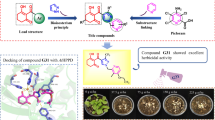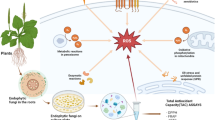Abstract
Microorganisms that bring about the aerobic transformation of imidacloprid (IMI) were isolated and screened, and the microbial regio- and stereoselective hydroxylation of IMI was studied. Some bacteria and fungi transformed IMI to 5-hydroxyl IMI. Bacterium Stenotrophomonas maltophilia CGMCC 1.1788 resting cells transformed IMI into R-5-hydroxyl IMI at the highest conversion rate. The enzyme catalyzed the stereoselective hydroxylation at position C12 of IMI in the imidazolidine ring. Under acidic conditions, 5-hydroxyl IMI was converted into olefin IMI in high molar conversion yield. The olefin IMI exhibited about 19 and 2.2 times more insecticidal efficacy than IMI against horsebean aphid imago and nymph, respectively, and about 1.4 times more active than IMI against brown planthopper imago. The transformation rate of IMI by resting cells of S. maltophilia CGMCC 1.1788 was promoted significantly by some carbohydrates and organic acids. The reaction medium with 5% sucrose resulted in 8.3 times greater biotransformation yield as compared with that without sucrose.




Similar content being viewed by others
References
Asperger O, Steinbrenner H, Lehmann A, Petsch M, Griengl H (1999) Induction and functional role of cytochromes P450 in the filamentous fungi Mortierella alpine ATCC 8979 and Cunninghamella blakesleeana DSM 1906 during hydroxylation of cycloalkylbenzoxazoles. Appl Microbiol Biotechnol 51:516–522
Bradford M (1976) A rapid and sensitive method for the quantification of microgram quantities of protein utilizing the principle of protein dye binding. Anal Biochem 72:248–254
Caroline C (2001) Imidacloprid. J Pestic Reform 21:15–21
Claude B, Davin-Regli A, De Micco P (1995) A simple method for selective isolation of Stenotrophomonas maltophilia from environmental samples. Appl Environ Microb 61:1653–1654
Holland HL (2000) Stereoselective hydroxylation reactions. In: Patel RN (ed) Stereoselective biocatalysis. Marcel Dekker, New York, pp 131–152
Hurek T, Wagner B, Reinhold-Hurek B (1997) Identification of N2-fixing plant- and fungus-associated Azoarcus species by PCR-based genomic fingerprints. Appl Environ Microbiol 65:4331–4339
Krohn J, Hellpointner E (2002) Environmental fate of imidacloprid. Pflanzenschutz-Nachr Bayer 55: 3–26 (special edition)
Lewis D, Hlavica P (2000) Interactions between redox partners in various cytochrome P450 systems: functional and structural aspects. Biochim Biophys Acta 1460:353–374
Liu W, Zheng W, Gan J (2002) Competitive sorption between imidacloprid and imidacloprid-urea on soil clay minerals and humic acids. J Agric Food Chem 50:6823–6827
Nagasawa T, Hurh B, Yamamne T (1994) Production of 6-hydroxynicotinic acid from nicotinic acid by resting cells of Pseudomonas fluorescens TN5. Biosci Biotechnol Biochem 58:665–668
Nauen R, Tietjen K, Wagner K, Elbert A (1998) Efficacy of plant metabolites of imidacloprid against Myzus persicae and Aphis gossypii (Homoptera: Aphididae). Pestic Sci 52:53–57
Nauen R, Rechmann U, Armborst S, Stupp HP, Elbert A (1999) Whitefly-active metabolites of imidacloprid: biological efficacy and translocation in cotton plants. Pestic Sci 55:265–271
Nauen R, Ebbinghaus-Kintscher U, Schmuck R (2001) Toxicity and nicotinic acetylcholine receptor interaction of imidacloprid and its metabolites in Apis mellifera (Hymenoptera: Apidae). Pest Manag Sci 57:577–586
Rouchaud J, Gustin F, Wauters A (1994) Soil biodegradation and leaf transfer of insecticide imidacloprid applied in seed dressing in sugar beet crops. Bull Environ Contam Toxicol 53:344–350
Rouchaud J, Gustin F, Wauters A (1996) Imidacloprid insecticide metabolism in sugar beet field crops. Bull Environ Contam Toxicol 56:29–36
Sabate J, Grifoll M, Vinas M, Solanas A (1999) Isolation and characterization of a 2-methylphenanthrene utilizing bacterium: identification of ring cleavage metabolites. Appl Microbiol Biotechnol 52:704–712
Sarkar MA, Sankhajit R, Kole R, Chowdhury A (2001) Persistence and metabolism of imidacloprid in different soils of West Bengal. Pest Manag Sci 57:598–602
Schoning R (2001) Analytical method for the determination of residues of imidacloprid, NTN 33893-5-hydroxyl, and NTN 33893-olefin by HPLC with electrospray MS/MS-detection in plant and other materials: honey, nectar, bees, wax, corn (pollen, leaves), rape (pollen, flowers, leaves), sunflowers (pollen, flowers, leaves), tree (leaves, flowers), horse chestnuts. Pflanzenschutz-Nachr Bayer 54:413–452
Schulz-Jander D, Casida J (2002) Imidacloprid insecticide metabolism: human cytochrome P450 isozymes differ in selectivity for imidazolidine oxidation versus nitroimine reduction. Toxicol Lett 132:65–70
Suchail S, Debrauwer L, Belzunces L (2004) Metabolism of imidacloprid in Apis mellifera. Pest Manag Sci 60:291–296
Uchida A, Yoshida T, Ogawa M, Nagasawa T (2003) Regioselective hydroxylation of quinolinic acid, lutidinic acid and isocinchomeronic acid by resting cells of pyridine dicarboxylic acid-degrading microorganisms. Appl Microbiol Biotechnol 62:337–341
Wahl P, Walser-Volken P, Laumen K, Kittelmann M, Ghisalba O (1999) Microbial production, purification, and characterization of (S)-specific N-acetyl-2-amino-1-phenyl-4-pentene amidohydrolase from Rhodococcus globerulus K1/1. Appl Microbiol Biotechnol 53:12–18
Woo PCY, Lau SKP, Fung AMY, Chiu SK, Yung RWH, Yuen KY (2003) Gemella Bacteraemia characterised by 16S ribosomal RNA gene sequencing. J Clin Pathol 56: 690–693
Acknowledgements
We are thankful for support from the 10th Five Years Project for the National Key Technologies R&D Program (2004BA308A22-12) and the Jiangsu Academic Natural Science Foundation (04KJB180071). We especially thank Dr. Ji-Hua Liu of China Pharmaceutical University for conducting M.S. studies and Dr. Jia-Hong Zhou for conducting NMR studies. We sincerely acknowledge Dr. Bing-Xiang Wang for analytical assistance.
Author information
Authors and Affiliations
Corresponding author
Rights and permissions
About this article
Cite this article
Dai, Yj., Yuan, S., Ge, F. et al. Microbial hydroxylation of imidacloprid for the synthesis of highly insecticidal olefin imidacloprid. Appl Microbiol Biotechnol 71, 927–934 (2006). https://doi.org/10.1007/s00253-005-0223-3
Received:
Revised:
Accepted:
Published:
Issue Date:
DOI: https://doi.org/10.1007/s00253-005-0223-3




